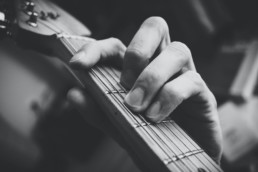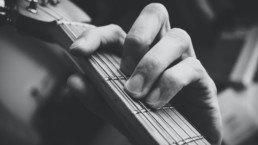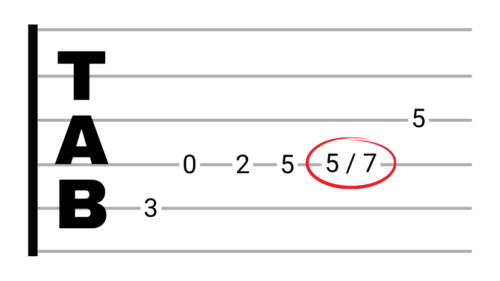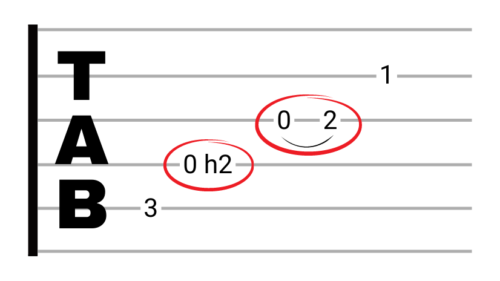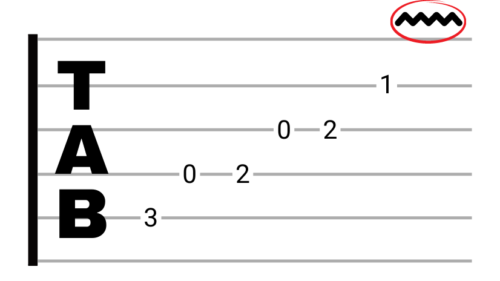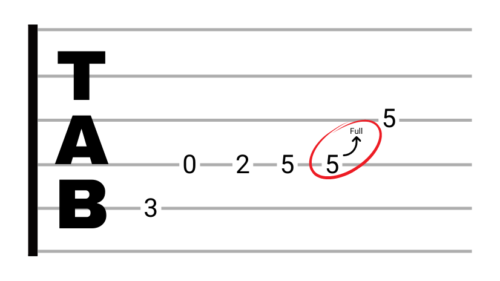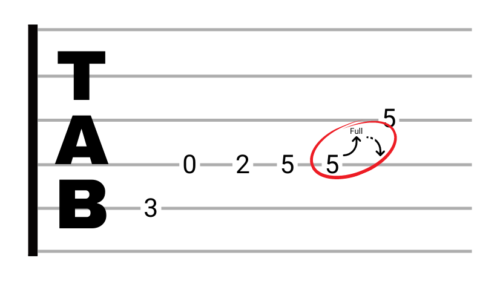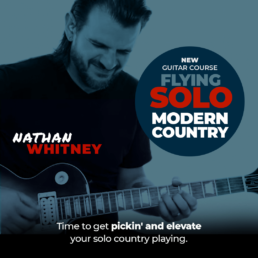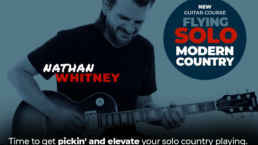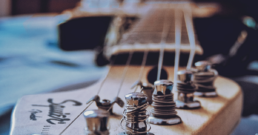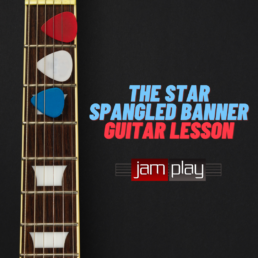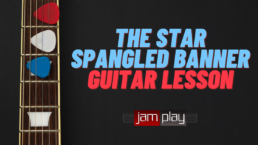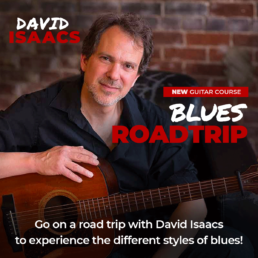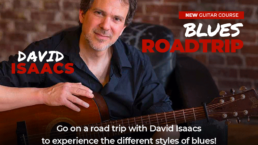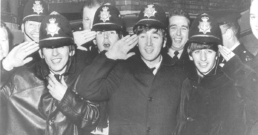How To Read Guitar Tab - A Beginner's Guide
Starting to play guitar is (almost) always a daunting task. It’s very normal to feel discouraged by the difference in skill level between you and some of your favorite players. But there are plenty of tried and true tools that can help you tackle the learning curve. One of the most helpful tools for guitarists is tablature, or ‘tab‘ for short, which is a way of transcribing instrument fingerings instead of musical pitches. And, contrary to popular belief, tabs are not a modern invention to help lazy guitar players. Tablature has been around since the 14th century, was popular during the Baroque and Renaissance periods, and was used to learn many different instruments. So feel no shame when checking out guitar tabs for your favorite songs, regardless of your level of playing!
Today we’ll be showing you how guitar tabs can be interpreted. So, without further ado, let’s learn how to read guitar tabs!
The Basics of Guitar Tab
Before we dive into the symbols that notate different guitar techniques, let’s get the very basics out of the way. As we mentioned, tabs display fingerings on a guitar rather than musical notes. Here’s what to expect when looking at tab:
The Lines
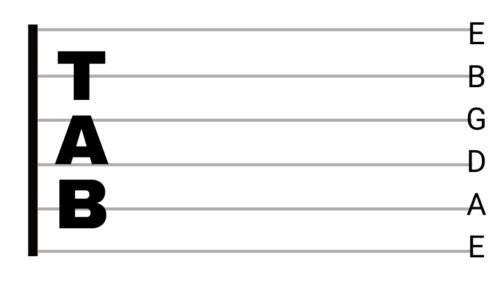 Guitar tab gives us a crude timeline displaying the strings in descending order of pitch. In the tab pictured above, you can see the top line represents the high E string (if in standard tuning), while the bottom line represents the low E string. We should note that many popular songs feature alternate tunings and the use of a capo. This information will usually be provided in the beginning of guitar tab sheets alongside the key and tempo of the song.
Guitar tab gives us a crude timeline displaying the strings in descending order of pitch. In the tab pictured above, you can see the top line represents the high E string (if in standard tuning), while the bottom line represents the low E string. We should note that many popular songs feature alternate tunings and the use of a capo. This information will usually be provided in the beginning of guitar tab sheets alongside the key and tempo of the song.
The Numbers
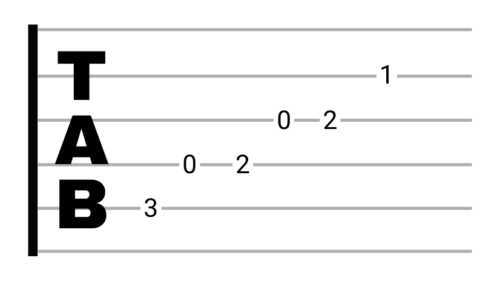 The most valuable information we get from guitar tabs is where to place our fingers. Fingerings for guitar parts are notated by numbers, which tell us which fret to hold in order to play the right notes, and in which order. Above is an example of a single-note line that outlines the C major pentatonic scale. The first number that appears is a “3” on the fifth line down. So, to play this note, we would place a finger on third fret of the fifth string. The next number is a “0” on the fourth line from the top. “0” always represents a note that is not fretted, so we would play this by striking the open fourth string. But, what if notes are played at the same time? The image below illustrates how we notate chords, or multiple notes played simultaneously.
The most valuable information we get from guitar tabs is where to place our fingers. Fingerings for guitar parts are notated by numbers, which tell us which fret to hold in order to play the right notes, and in which order. Above is an example of a single-note line that outlines the C major pentatonic scale. The first number that appears is a “3” on the fifth line down. So, to play this note, we would place a finger on third fret of the fifth string. The next number is a “0” on the fourth line from the top. “0” always represents a note that is not fretted, so we would play this by striking the open fourth string. But, what if notes are played at the same time? The image below illustrates how we notate chords, or multiple notes played simultaneously.
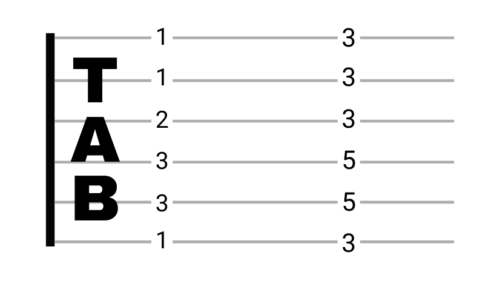 Since we read guitar tabs sequentially from left to right, any time you see notes that are directly in line with each other vertically, this means they are played simultaneously. This tab notates an F major barre chord (the chord being played in the image near the top of this blog) followed by a G minor chord.
Since we read guitar tabs sequentially from left to right, any time you see notes that are directly in line with each other vertically, this means they are played simultaneously. This tab notates an F major barre chord (the chord being played in the image near the top of this blog) followed by a G minor chord.
Other Common Guitar Tab Symbols & Notations
Now that we’ve covered the very basics, it’s time to look at some other symbols you’ll encounter when learning your favorite songs.
Slashes & Sloping Lines
When learning a lead guitar part or solo, it’s common to come across forward or back slashes. These indicate there is a slide between notes. If you see a smaller number followed by a “/” or upward sloping line, and then a larger number (as seen above), this mean you should slide up from the lower fret to the higher one. You’ll slide down when the first number is larger and there is a “\” or downward sloping line in between.
‘H,’ ‘P,’ & Legato Ties
In music, the term “legato” refers to notes being strung together without space between them. In other words, legato happens when the end of one note is immediately followed by the start of another. We achieve this on the guitar by using hammer-ons and pull-offs. In guitar tabs, this is notated two different ways. You will either see two notes separated by an “h” (for hammer-on) or a “p” (for pull-off), or you will see a tie between notes regardless if they’re to be a hammered-on or pulled-off. In the image above, notice how two hammer-ons in the same position are notated different ways.
Wavy Lines
The term “vibrato” refers to the rapid oscillation in pitch when sustaining a note. This is not to be confused with a trill, which is a rapid succession of hammer-ons and pull-offs between two notes. You’ve likely seen vibrato in action if you’ve watched any blues guitar players shake a note during a solo; this is one of the most expressive techniques available to guitar players. We notate vibrato in guitar tabs by displaying a wavy line above the staff and the note that should be played with vibrato. Reading the tab above, only the final C note should be played with vibrato.
Curved Arrows
Curved Arrows in guitar tab signify a string bend. And, accompanying the arrow is usually the word “Full” or the fraction “1/2.” When the word, “Full” appears, the note is intended to be bent up a whole step, or the equivalent of two frets. This is the case with the image above.
In this next case, there is a second arrow that points downward. The second arrow lets us know the note should be un-bent to its original position after reaching the desired interval of the bend. These notations are very common if you’re reading guitar tab for blues, country, and rock music.
Although there are other symbols you’ll come across when reading guitar tabs, the ones we’ve listed here are the most common. We hope this helps you get a head start on learning your favorite songs on guitar. Happy playing!
For an ever-growing library of Song Lessons complete with guitar tab, check out JamPlay.com! JamPlay has over 450 guitar courses from 120+ instructors, and online guitar lessons tailored to every skill level, music genre, and playing style. Click here to learn more.
Share this
Become a JamPlay member for unlimited access to 7000+ guitar lessons and 120+ artists and instructors. View membership plans ›
Related Posts
July 12, 2022
Nathan Whitney's Flying Solo: Modern Country Guitar Course
You’ve gotten your country guitar rhythm chops down, and now you’re interested in learning to play lead. But taking a solo at any gig seems daunting at this point. You know some skills and have some favorite guitar players in mind. Where do you begin learning to play like them? The answer is: at the beginning like all of your favorite guitar heroes.
Luckily, you’ve got one of the best country guitar teachers anyone could ask for. In his course, Flying Solo: Modern Country, Nathan Whitney (right-hand guitar player to country music star, Thomas Rhett) shows you how you can take your fundamental knowledge and apply it to learning how to solo for country guitar.
About the Course:
One of the best ways to learn a guitar solo is to break it down step by step. That is exactly how Nathan Whitney guides you in his course, Flying Solo: Modern Country. By practicing individual licks, then connecting them, you’ll play your way through three distinct guitar solos.
Throughout the course, you’ll get a feel for different styles of lead country guitar. Each of the three solos is rooted in Classic Country, Urban Melodies, and Country Fried Rock, respectively. Honing techniques such as double stops, hybrid picking, alternate picking, and string bending will be crucial for learning these rockin’ solos!
Try it out!
Here’s an example of one of the solos you’ll be learning with Nathan Whitney. For the full JamPlay course, complete with individual guitar lick breakdowns, guitar tab, notation, & jam tracks, check out Nathan Whintey’s Flying Solo: Modern Country!
For an ever-growing library of Song Lessons, check out JamPlay.com! JamPlay has over 450 guitar courses from 120+ instructors, and online guitar lessons tailored to every skill level, music genre, and playing style. Click here to learn more.
Share this
Become a JamPlay member for unlimited access to 7000+ guitar lessons and 120+ artists and instructors. View membership plans ›
Related Posts
July 7, 2022
What Type of Guitar Strings Should I Use?
What Type of Guitar Strings Should I Use?
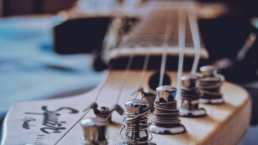
Have you ever found yourself in a music store and felt overwhelmed by the sheer number of guitar strings options? You are not alone. There almost seem like too many options. And, to the untrained eye, it might just seem like a lot of brands offering the same product. However, as a guitar player, it’s important for you to know that there are so many options because there are many different types of strings that are all used for different applications. Here, we are going to explore which type of guitar strings is best for YOU and what you are playing.
First, we’ll take a look at what different materials guitar strings can be composed of. Then we’ll touch on how strings are constructed differently. And finally, we’ll tell you why that matters for the type of music you are playing. Let’s get started!
 Different String Materials for Different Guitars
Different String Materials for Different Guitars
When you look at most guitars, it’s clear to see that most of them are strung with some type of metal. But did you know the type of metal has an effect on the tone and feel of the strings when you play them? And what about those clear, plastic-y looking strings you see on some acoustic guitars? Let’s take a closer look.
Electric Guitars
Electric guitars are almost always strung with one of two types of metal strings: steel or nickel. However, the former is the most common type. Generally, steel strings produce a brighter tone that cuts through the mix in a band setting. Nickel is a softer metal than steel, and you can feel this when you play them. They also produce a warmer, and low-end-present response. This can be less appealing if you are the lead guitar player, but proves very effective if you are playing rhythm parts.
Acoustic Guitars
Two different types of metals are used when stringing acoustic guitars: brass and bronze. Similarly to the tone difference you’ll find between steel and nickel electric guitar strings, brass strings tend to sound brighter, while bronze strings produce warmer tones.
Classical Guitars
Classical guitars, which are suited for playing Classical style guitar arrangements, are typically strung with a combination of materials. The highest three strings are traditionally pure, transparent nylon. The lower three strings are usually nylon wound with copper. If you are looking for classical guitar strings, you can find a generous selection of them over on Sweetwater.
 Types of Guitar Strings Construction
Types of Guitar Strings Construction
The tone and feel of guitar strings are also affected by how they are constructed. The construction of guitar strings usually depends on just a few variables.
The Core of The Guitar String
When looking down the middle of a wound guitar string, you’ll observe one of two variations. The core of a guitar string will either be hexagonal or round. Hex core strings will provide a more modern, louder and sharper tone. The tone produced by a round core string is more mellow, which is perfect for playing certain genres.
How The Guitar Strings are Wound
To be clear, when we are talking about how the strings are wound, we are referring to the lowest three or four strings that have noticeable ridges on them. The three main types of string winding are round wound, half round, and flat wound.
Round wound strings are ubiquitous; they can be found on most guitars if you are perusing a music shop. This is because they are the most versatile. In fact, if you are using nickel plated round wound strings, you will likely have a place in any band setting if you’ve got the skills to match. But, generally speaking, round wound guitar strings have the potential to produce higher, brighter frequencies than the other types.
The next strings down on the brightness scale are half round guitar strings. They are called half round strings because the actual cord that is wound around the core has retained most of its roundness, but also features a flat face. These strings will produce a warmer tone, but also achieve some of the brightness you’d want if you were playing lead.
Flat wound strings are the most warm of these options, and have mostly niche applications because of their limited frequency response. Unlike those that are round wound, flat wound guitar strings will appear smooth instead of lined with ridges.
The Gauge of The Strings
Finally, the gauge, or the thickness of the strings plays a huge role in their tone and feel. Thicker gauges are going to produce a warmer sound and sustain better. But, they will also be tougher to press into the fret if you are just starting out, and they bend much less easily. Thinner gauges will sound a slightly more thin, but don’t let that deter you. Some genres call for this type of tone, especially if you need to do a lot of string bending!
 What Type of Guitar Strings Should YOU Use?
What Type of Guitar Strings Should YOU Use?
This is the reason you opened this article, and we won’t keep you waiting any longer! Let’s take a look at some of the most popular genres for guitar players and see what types of guitar strings are superior first picks!
Metal
If you play guitar in a metal band, you are going to want strings that compliment the heavy levels of distortion through which you’ll be routing your signal. Also, you are going to want to air on the side of ‘heavy’ to accommodate any drastic drop tunings. So, the next time you outfit your axe for metal, try some nickel plated, round wound, hex core steel strings that come with thicker gauges in the lower strings. Our friends over at Sweetwater even have their own favorites in this category!
Rock
Rock guitar can call for a couple different types of strings, depending on how ‘classic’ the rock is! Modern rock styles may require a brighter tone, so you’ll either want to stick to at least nickel plated steel strings with hex cores. We would recommend always going with round wound strings with a medium to light gauge. This will allow you to get the bite you’re looking for when ripping power chords, but the flexibility to bend strings when it’s time to shred. Here are some great options on Sweetwater!
If you find yourself in a more classic rock setting and you’re holding an electric guitar, consider going with a set of pure nickel guitar strings. These will give you some of that extra body and punch that pairs well with a classic fuzz pedal. Try these D’Addario strings out! However, if you’re supporting the lead guitarist with an acoustic, definitely set yourself up with some brass strings. These will be bright enough to add some jangle to the tune without distracting from the vocalist. Here’s a set that we recommend!
Blues
When you’re playing the blues, you’re looking for sweet, warm tones regardless of your place in the band. So, if you’re rocking an electric guitar, get your hands on some round wound or half round, pure nickel strings with a medium to light gauge. You’ll get the warmth you’re looking for, with the bend-ability you’ll need for soloing. Try out these pure nickel strings on Sweetwater!
For playing acoustic blues, you’ll still be chasing that warmer, more resonant tone. So, here’s a set of phosphor bronze strings that should do the trick!
Country
Twang is the thang when you’re holding down the hootenanny with some country guitar playing! If you’re rocking an electric guitar, you’ll want brightness to pair with your single-coil neck pickup. So, we recommend round wound, nickel plated, hex core strings with a light enough gauge to support bending. Take your pick over at Sweetwater!
For acoustic playing, consider something bring like those we recommended for playing classic rock above!
Jazz
If you are playing acoustic or electric jazz guitar, 95% of the time you’ll be holding down the rhythm section with the drummer and upright bassist. And when it’s time to solo, sharp tones should be the last thing you endeavor for. In all cases, you’ll want the warmest, smoothest tones available. So, you’ll want to grab yourself a set of flat wound strings for minimal finger sliding sounds, and buttery warm tones. You may also consider going with a slightly heavier gauge string for better sustain and better low-end response. Thomastik-Infeld makes some decent strings for jazz playing; try these for acoustic playing, and these for electric!
Classical
Lastly, the tone you get out of a classical guitar is paramount to a perfect performance. Many things factor into this, including the resonance of the instrument’s wood and shape, the fingerstyle technique of the performer, and of course the quality of the strings. In modern days, classical guitar strings are always made with nylon (they were, at one time, made from silk wound with catgut). You can find an amazing selection of nylon classical guitar strings over at Sweetwater!
Excited to look at some new guitar strings? Find all kinds of great gear deals over at Sweetwater.com.
For guitar lessons that teach you how to use effects like these, check out JamPlay.com! JamPlay has over 450 guitar courses from 120+ instructors, LIVE daily instruction, and online guitar lessons tailored to every skill level, music genre, and playing style. Click here to learn more.
Share this
Become a JamPlay member for unlimited access to 7000+ guitar lessons and 120+ artists and instructors. View membership plans ›
Related Posts
The Star Spangled Banner Guitar Lesson
One thing you probably didn’t know about the United States’ national anthem is that it was mainly created by two different people. The lyrics that we, in the U.S., learn to recite at a young age were written in 1814 by Francis Scott key, a lawyer from Maryland. The music, however, was originally a tune called “To Anacreon in Heaven” written in 1780 by a composer named John Stafford Smith. The lyrics and music were later combined to form “The Star Spangled Banner,” which was adopted at the U.S. national anthem in 1931.
In almost a century’s time, countless musicians, composers, conductors, and orchestras have recited their own versions of this anthem – some of them being guitar players! In fact, one famous instance of a U.S. National Anthem guitar performance was Jimi Hendrix‘s at the Woodstock Music and Art Festival in 1969. Today, we’re going to show you how you can play “The Star Spangled Banner” on guitar!
Performance & Tips for Expressive Playing
In this lesson, David MacKenzie shows you how to play “The Star Spangled Banner” on guitar. As David explains, you can use techniques such as string bending, vibrato, hammer-ons, pull-offs, and even slides to add expression and musicality to the performance.
For an ever-growing library of Song Lessons, check out JamPlay.com! JamPlay has over 450 guitar courses from 120+ instructors, and online guitar lessons tailored to every skill level, music genre, and playing style. Click here to learn more.
Share this
Become a JamPlay member for unlimited access to 7000+ guitar lessons and 120+ artists and instructors. View membership plans ›
Related Posts
June 30, 2022
David Isaacs' Blues Roadtrip Guitar Course
So, you’ve been playing guitar for a few months (or however long) and you a have a good understanding of the basics. But now, you’re interested in carving out a more focused path for yourself. You keep hearing that most modern popular music is derived, in some fashion, from the Blues. But what is the Blues and where did it come from? How can I play the Blues? David Isaacs helps elucidate the answers to those questions for you in his new JamPlay guitar course, Blues Roadtrip.
About the Course:
The course’s concept is simple: David Isaacs takes you on a Blues “road trip” to parts of the world where different sub-genres of Blues music were born. The Mississippi Delta, Chicago, Memphis, New Orleans, Texas, and even Great Britain are all places that birthed their own microcosms of Blues music.
Along the way, David introduces you to integral Blues guitar concepts and techniques such as open & barre chords, string bending, single-note melodies, and more. This course is perfect for guitar players who are relatively new, but already have some core guitar paying concepts under their fingers.
Try it out!
But don’t just take it from us. Here’s a free lesson from David’s course. In this lesson, David performs and breaks down a lick based on a groove you would hear in the Mississippi Delta – considered to be the original birthplace of Blues music. For the full course, complete with tab, notation, & jam tracks, check out David Isaacs’ Blues Roadtrip guitar course on JamPlay!
For an ever-growing library of Song Lessons, check out JamPlay.com! JamPlay has over 450 guitar courses from 120+ instructors, and online guitar lessons tailored to every skill level, music genre, and playing style. Click here to learn more.
Share this
Become a JamPlay member for unlimited access to 7000+ guitar lessons and 120+ artists and instructors. View membership plans ›
Related Posts
June 29, 2022
3 Beatles Songs to Learn on Guitar (Global Beatles Day)
3 Beatles Songs to Learn on Guitar (Global Beatles Day)
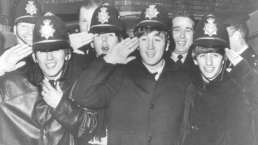
The Beatles, also known as “the fab four,” consisted of Paul McCartney, John Lennon, George Harrison, and Ringo Starr. In the mid-to-late 1960s, they were considered synonymous with pop culture globally. The group released 21 studio albums amongst over 200 other publications, and made copious television and stage appearances before disbanding in 1970. However, this legendary quartet’s influence spans far past its heyday. The Beatles have inspired countless singers, songwriters, producers, drummers, bass player, and guitarists since their stardom, and continue to inspire musicians today.
In 2009, a Beatles fan proposed that June 25th be proclaimed Global Beatles Day to honor the band’s participation in the 1967 BBC special, Our World. The holiday caught on, and that’s why we are celebrating today! JamPlay offers a number of comprehensive Beatles song lessons, but today we’re celebrating by showcasing a few. So, here are 3 Beatles songs to learn on the guitar!
Beatles Song #1 – “A Hard Day’s Night”
Instantly recognizable by the opening chord played on John Lennon’s Rickenbacker 12-String guitar, “A Hard Day’s Night” is a timeless rock ‘n roll hit. This Beatles son topped the charts in both the US and the UK when released as a single.
In this performance, John Auker demonstrates the main guitar parts for “A Hard Day’s Night.” One of the guitars that John uses is the same type of Rickenbacker 12-String guitar that was used on the original recording. For the breakdown of this tune, check out John Auker’s full song lesson on JamPlay.
Beatles Song #2 – “Yesterday”
A fun fact about “Yesterday” is that almost no other song in recording history has been covered as much as this one. This wistful tune was the first Beatles song that featured a solo performance, as only Paul McCartney’s voice, an acoustic guitar, and a string quartet comprise the arrangement.
In this lesson, Marcelo Berestovoy performs a solo guitar version of “Yesterday” before analyzing the song’s chord progression. For the breakdown of this iconic tune, check out Marcelo’s full song lesson on JamPlay.
Beatles Song #3 – “Can’t Buy Me Love”
The UK’s fourth best-selling single of the ’60s, “Can’t Buy Me Love” is truly one of the most infectious Beatles songs. This internationally chart-topping behemoth of a hit is also the 295th mention on Rolling Stone Magazine’s list of the 500 Greatest Songs Of All Time.
In this performance, Dennis Hodges demonstrates how to play the chord progression and guitar parts for “Can’t Buy Me Love.” For the breakdown of this Beatles song, check out Dennis’ full song lesson on JamPlay.
Excited to look learn more Beatles songs? Check out JamPlay.com! JamPlay has over 450 guitar courses from 120+ instructors, and online guitar lessons tailored to every skill level, music genre, and playing style. Click here to learn more.
Share this
Become a JamPlay member for unlimited access to 7000+ guitar lessons and 120+ artists and instructors. View membership plans ›
Related Posts
5 Famous Guitar Parts To Learn This Summer
5 Famous Guitar Parts To Learn This Summer

There’s no denying it: Summer 2022 has arrived. School is out, people are embarking on long-awaited vacations, and it’s HOT (well, if you live in the Northern Hemisphere). But what’s even hotter is the ever-growing songbook of summertime anthems. Over the years, musicians and bands have released countless songs that just feel right to crank through your car’s stereo on a summer’s day. And many of the most popular tunes on the list feature recognizable, ear-worm-level lead guitar parts. Today, we’re checking out 5 famous guitar parts you can learn this summer. Let’s dive right in!
1. “Sunshine of Your Love” by Cream
If you are a relatively new guitar player, listen up! Some of your favorite guitarists probably learned this classic, fuzzed guitar riff at some point in their career. “Sunshine of Your Love” is Cream’s second track on their 1967 album, Disraeli Gears, and is still played on radio stations worldwide. The iconic, Jimi-Hendrix-inspired lead guitar part that glues this track together features all the pentatonic, chromatic, vibrato’d tones you love about ’60s blues rock.
In this performance video, Chris Buono shows you how the main guitar parts work together. For the breakdown of how to play this iconic riff, check out Chris Buono’s full song lesson on JamPlay.
2. “Brown Eyed Girl” by Van Morrison
Also released in 1967, “Brown Eyed Girl” is one of the most radio-played hits in the history of modern music. This calypso-infused classic features an iconic double stop guitar part, feel-good chord progressions, and lyrics about the joys of youth. This summer song is perfect for learning on guitar, especially if your are a beginner to playing.
In this lesson, JamPlay educator, Mike Henecke provides a little bit of the song’s history before teaching you how to play its famous double stop guitar part. For the full breakdown of the song, check out Mike Henecke’s song lesson on JamPlay.
3. “Are You Gonna Be My Girl” by Jet
Hailing from the land Down Under, Jet made waves in the summer of 2003 with their debut hit “Are You Gonna Be My Girl.” Although it feels wrong to call a song from 2003 a “classic” summer song, it has broken the top 20 on so many charts worldwide, we feel it has earned this title. One of the most recognizable features of this song is a bendy, distorted electric guitar part that’s perfect for learning this summer.
Here, David Wallimann shows you how to play this blazin’ electric guitar riff. For the For the breakdown of the song, check out David Wallimann’s full “Are You Gonna Be My Girl” song lesson on JamPlay.
4. “Day Tripper” by The Beatles
Here’s another tune that’s famously carried by an iconic guitar riff. “Day Tripper” was the Beatles’ 1965 double A-Side single accompanying “We Can Work It Out.” Though the record was released in December, the summertime vibes of the lead electric guitar part are undeniable. As the 7th greatest selling single of the 1960s, this is one classic you should absolutely learn this summer!
In this performance, JamPlay educator, John Auker demonstrates how the different guitar parts work together in “Day Tripper.” For the For the breakdown of the song, check out John Auker’s full song lesson on JamPlay.
5. “It’s Five O’ Clock Somewhere” by Alan Jackson & Jimmy Buffett
This last tune is one you’ve probably heard if you’ve ever seen live music at a bar or beach lounge. This is because “It’s Five O’ Clock Somewhere” references the popular phrase that excuses drinking alcohol at any time of the day. No matter what your time zone you are in, it’s probably happy hour somewhere on the globe. This 2003 hit, naturally, features an emblematic bluesy guitar part that evokes feelings of relaxation in the sun.
In this performance, David Wallimann demonstrates the electric blues guitar parts in “It’s Five O’ Clock Somewhere.” The lead riff features pentatonic runs, string bends, and some sweet sounding double stop descending thirds. For the For the breakdown of the song, check out David Wallimann’s full song lesson on JamPlay.
For an ever-growing library of Song Lessons, check out JamPlay.com! JamPlay has over 450 guitar courses from 120+ instructors, and online guitar lessons tailored to every skill level, music genre, and playing style. Click here to learn more.
Share this
Become a JamPlay member for unlimited access to 7000+ guitar lessons and 120+ artists and instructors. View membership plans ›
Related Posts
60% OFF JamPlay Annual Memberships
JAMPLAY.COM SUMMER 2022 SALE
Better Guitar Playing Starts Here.
60% OFF Annual Memberships - Our Best Deal to Date!
Welcome to our Super Summer Solstice SALE – Grab an Annual Membership at 60% OFF! JamPlay is the best place to begin your journey as a guitarist. Explore thousands of on-demand video guitar lessons from beginner level on up, spanning 20+ music genres and playing styles. Plus, enjoy the ever-growing library of in-depth Song Lessons.
THIS SALE HAS ENDED
-
100+ Teachers
-
400+ Courses
-
All Genres – Beginner to Advanced
-
Master Courses with Artists such as Aaron Marshall, Yvette Young, Mike Dawes, Phil Keaggy and more.
-
Live Courses
-
1 on 1 Reviews
-
Resource Libraries
-
And Much More!
THIS SALE HAS ENDED
Share this
Related Posts
4 Types of Guitars You'll See on Stage
4 Types of Guitars You'll See on Stage

If you’ve ever been to a rock concert, or seen a video of one, you might have noticed something: there are usually a few different guitars on stage. And if you are new to guitar, or aren’t so familiar with guitar playing, you might have wondered, “why?” One of the reasons for this is that each player usually has a different role in the performance. Some guitarists play rhythmic parts. Some guitarists play lead melodies and licks. And often times you’ll find that these different roles require different types of guitars. So today, we’re going to break down 4 of main types of guitars you’ll find on the stage.
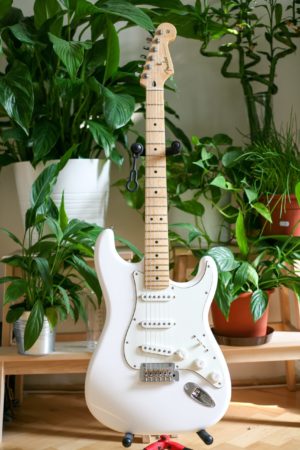
1. Electric Guitars
The electric guitar is probably the most common type of axe you’ll find up on the stage. Electric guitars rely on magnetic pickups that translate string vibrations into electrical energy. This energy then travels via an audio cable to an amplifier and speaker, which produce the guitar’s sounds. Though pickups are generally interchangeable, some guitar models are known and designed for certain types of playing. For example, the guitar in this photo is a Fender Stratocaster, which is popularly associated with lead guitar legends like Eric Clapton and David Gilmour. Other types of “lead” electric guitars you’ll see, especially at metal or math rock shows, are 7 or 8-string guitars. Schecter and Ernie Ball are two manufacturers known for their selections of these types of guitars!
Other electric guitars have pickups and builds that are better suited for strumming and rhythm playing. The Rickenbacker 325, for example, was a favorite of one of the most famous rhythm guitar players in history, John Lennon. Another feature of some rhythm-oriented electric guitars is a hollow or semi-hollow body. Gibson’s notorious ES-335 model is a prime example of a semi-hollow body electric guitar.
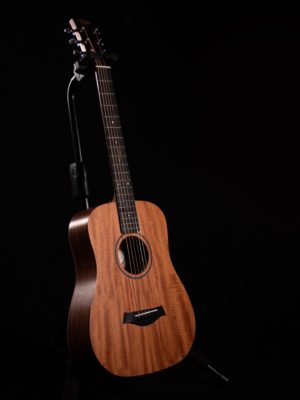
2. Acoustic Guitars
If you’re at a rock show, you may only see an acoustic guitar once or twice (if at all) during the performance. This type of guitar utilizes the resonance of a hollow wooden body to amplify the sound of its strings. And thus, acoustic guitars are more popularly used to accompany solo singers or small acoustic bands. They are also used to add a lighter rhythmic textures to full band performances.
Of the types of guitars we’re covering here, the acoustic guitar is probably the one you have seen at your friend’s house, being played on a street corner, or being strummed at a campfire. One of the main reasons for their universal popularity is that they are very portable and require no other equipment to deliver a performance. You can find a HUGE selection of affordable acoustic guitars on Sweetwater!

3. 12-String Guitars
A 12-string guitar might be tough to spot from the crowd if you don’t know what to look for. Appearing almost identical other electric or acoustic axes, the 12-string is one of the types of guitars that is mainly used for supporting the rhythm and underlying harmony of a song. If you’ve never seen one before, 12-string guitars feature six pairs of strings, eight of which are typically in standard tuning. The first two pairs are tuned in unison to E and B respectively. Then the next four pairs are tuned in octaves to G, D, A, and E. So, when it comes to learning how to play a 12-string, it’s not much different than learning on a standard 6-string!
In this photo, 1970s no wave rocker, Arto Lindsay wields a Danelectro Hawk 12-string guitar. Notice the machine heads on the headstock – there are 6 on each side! Thought these particular vintage models are hard to come by, you can find similar ones on Sweetwater!

4. Bass Guitars
Speaking of the rhythm section, you have probably never been to a concert where a there wasn’t a bass guitar. Unlike other types of guitars, bass guitars are not typically used to play chords or solos. Instead, a bassist’s typical duties include providing a harmonic foundation, “locking in” rhythmically with the drummer, and emphasizing the groove of the song. These duties are underpinned by the thick strings on a bass, which help produce sub frequencies that are essential to the overall feeling of any tune.
Some famous bass players you might recognize are Sting (The Police), Flea (The Red Hot Chili Peppers), and Sir Paul McCartney. Feeling inspired to grab a bass of your own? You can find a massive selection of them over at Sweetwater!
Excited to look at some new gear? Find all kinds of great guitar gear deals over at Sweetwater.com.
For guitar lessons that teach you how to use effects like these, check out JamPlay.com! JamPlay has over 450 guitar courses from 120+ instructors, LIVE daily instruction, and online guitar lessons tailored to every skill level, music genre, and playing style. Click here to learn more.
Share this
Become a JamPlay member for unlimited access to 7000+ guitar lessons and 120+ artists and instructors. View membership plans ›
Related Posts
6 Famous Guitar Pedals You Should Know
6 Famous Guitar Pedals You Should Know

When the electric guitars first hit the scene in the late 1930s, a new world of possibilities opened up. Effectively, a novel instrument was born. And just like you could mute a trumpet, or prepare a piano, the sounds coming from an electric guitar could be manipulated too. This is where (you guessed it) electric guitar pedals made names for themselves.
The concept of compact guitar effects pedals surfaced as early as the late 1940s. However, the tools themselves didn’t become commercially viable until the 1960s. And since then, countless guitar pedals have come to market and found popularity – some of them making more ‘noise’ than others (pun intended). So, here are 6 famous guitar pedals you should know about!
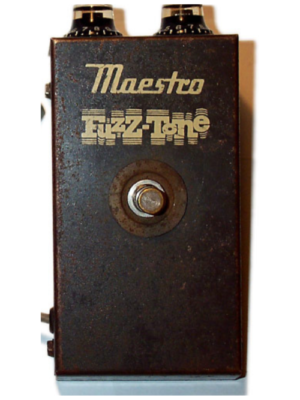
1. Maestro FZ-1 Fuzz-Tone Guitar Pedal
Technically, the DeArmond Trem Trol 800 is considered to be the first guitar pedal ever created. But, Gibson was the first to make a stomp box that was suitable for commercial distribution! The Maestro FZ1 Fuzz-Tone became quite popular after was used to record The Rolling Stones‘ 1965 superhit, “(I Can’t Get No) Satisfaction.” Though this model was discontinued in the 90s, its distant successor was released in 2022. You can find the Fuzz-Tone FZ-M for under $150 on Sweetwater!
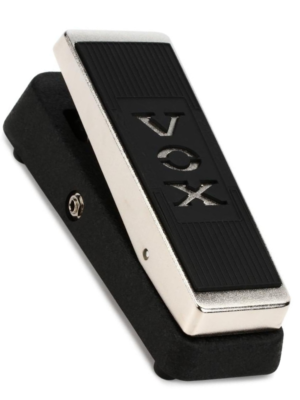 2. Vox V846 Wah Guitar Pedal
2. Vox V846 Wah Guitar Pedal
If you have ever listened to psychedelic rock or funk music, chances are you’ve heard the distinctive sounds of the ‘wah’ effect. The actual ‘wah’ sound happens when a moveable EQ band pass filter with a resonant peak moves up and down the frequency spectrum. The position of the peak is controlled by a ‘wah’ pedal’s seesaw foot switch. In the 1960s, VOX became a frontrunner in the ‘wah’ guitar pedal market with its unrivaled V846 model. This pedal achieved notoriety after guitar aficionados discovered it was Jimi Hendrix‘s preference during his 1969 Woodstock appearance. Though vintage V846 models are limited, VOX continues to produce a successor model, the V846-HW. You can find this pedal for under $250 on Sweetwater!
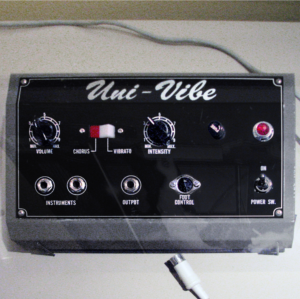
3. Uni-Vibe Phase Guitar Pedal
Some say it’s a chorus pedal, and some day it’s a vibrato pedal. Although it emulates both of these effects, the legendary Uni-Vibe was actually a versatile phaser (phase-shifting) pedal. Many speculate the effects this pedal produces were inspired by the oscillatory textures of a Leslie speaker. Pairing well with other effects like fuzz and reverb, the Uni-Vibe was a popular tool amongst 60s and 70s musicians, including Jimi Hendrix and Pink Floyd. Today, many pedal manufacturers offer their own spins on the classic Uni-Vibe sound. You can find one by MXR for under $130 on Sweetwater!
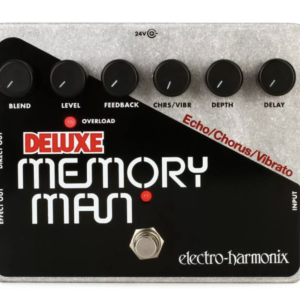 4. Memory Man Delay Guitar Pedal
4. Memory Man Delay Guitar Pedal
The original methods for achieving delay or echo effects involved using analog hardware. Magnetic tape machines were used to create real-time copies of an original input signal that was played back at a predetermined rate. The problem guitarists found was that this hardware was typically too bulky to be used reliably on stage. A compact console that could produce this effect became a reality with the use of solid-state technology. This is where the pedal manufacturer, Electro-Harmonix made a name for itself. The Deluxe Memory Man pedal became an essential tool for famous guitarists such as The Edge, Chris Cornell, and Jamie Cook. Since the pedal’s release in the 1970s, Electro-Harmonix has reissued several different versions of the pedal. This includes a few you can find on Sweetwater!
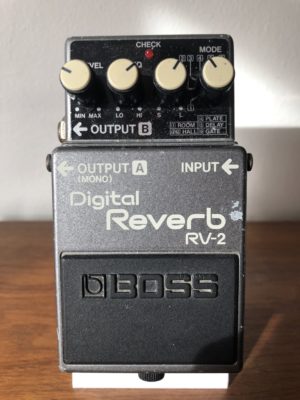
5. Boss RV-2 Reverb Guitar Pedal
Reverb is an effect you can experience in every day life. The cavernous sounds of a church, or the reflections you hear when singing in the shower are both examples of reverberation. In the audio world, this effect was originally recreated in a few different ways: metal springs and plates were often used to emulate the sound of a confined space. Digital reverb technology simplified all of this when it revolutionized the market in the 1970s. Then, in 1987, Boss revealed its compact RV-2 model that captured the textures of many legacy styles of reverb. This pedal quickly became popular with guitarists and has since become a benchmark for other guitar pedal manufacturers. You can find Boss’ latest iteration of this pedal, the RV-6 for under $180 on Sweetwater!
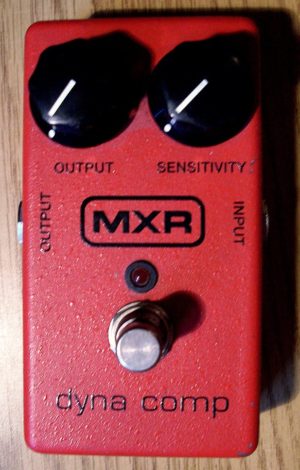
6. MXR Dyna Comp Guitar Pedal
Though technically not the first of its kind, the MXR Dyna Comp became one of the earliest, and most popular, compression stomp boxes after its 1972 debut. Compression was originally a tool that telephone manufacturers and record producers used to control the dynamic range audio. But guitarists eventually fell in love with the sonic qualities and ‘color’ that some compressors brought out of their amplifiers. The MXR Dyna Comp is one guitar pedal that has persisted throughout the years. You can find one for under $100 at Sweetwater!
Excited to look at some new gear? Find all kinds of great gear deals over at Sweetwater.com.
For guitar lessons that teach you how to use effects like these, check out JamPlay.com! JamPlay has over 450 guitar courses from 120+ instructors, LIVE daily instruction, and online guitar lessons tailored to every skill level, music genre, and playing style. Click here to learn more.
Share this
Become a JamPlay member for unlimited access to 7000+ guitar lessons and 120+ artists and instructors. View membership plans ›

